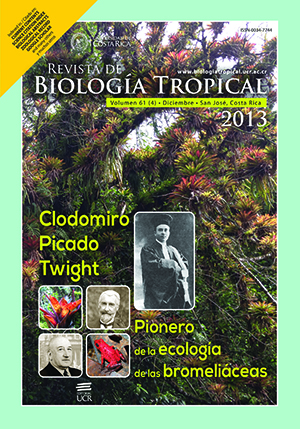Resumen
El Programa de Productividad Costera Marina del Caribe (CARICOMP) fue iniciado en 1993 para estudiar interacciones regionales a largo plazo entre la tierra y el mar, tomando mediciones estandarizadas de productividad y biomasa de manglares, arrecifes de coral y pastos marinos. Desde 1999 mediciones continuas de parámetros de pasto marino (Thalassia testudinum) así como datos ambientales han sido registrados para el Caribe de Panamá. Réplicas de estaciones fueron seleccionadas cerca del Instituto Smithsonian de Investigaciones Tropicales en Bocas del Toro. Núcleos de sedimento y cuadrantes fueron colocados para estimar biomasa y productividad, respectivamente. Valores promedio de productividad, biomasa foliar, tasa de recambio, biomasa total seca e Índice de Área Foliar fueron 1.74gDW/m2/d, 66.6gDW/m2, 2.62%/d, 1 481 gDW/m2, y 4.65, respectivamente. La biomasa total seca (haces, rizomas y raíces) e Índice de Área Foliar de T. testudinum incrementaron significativamente durante el periodo de estudio. Valores promedio de lluvia total, profundidad de disco de Secchi, temperatura superficial del mar y salinidad fueron 3 498mm, 8.24m, 28.79°C, y 32.26psu, respectivamente. La temperatura superficial del mar fue la única variable ambiental con un incremento estadísticamente significativo, de 1999 a 2010. La correlación entre la temperatura superficial del mar y los parámetros de T. testudinum (biomasa total y LAI) fueron tanto positivos como significativos. La población humana ha crecido dramáticamente durante los últimos diez años en la región de Bocas del Toro, incrementando la presión (deforestación, escorrentía, aguas negras) sobre los ecosistemas costeros (pastos marinos, manglares, arrecifes coralinos). Cambios en la abundancia de T. testudinum pueden estar ligados al calentamiento oceánico, como una consecuencia para satisfacer los requerimientos metabólicos de la planta, aunque es necesario analizar otros factores locales (reducción del pastoreo e incremento en la eutrofización). Un mayor calentamiento del océano puede tener efectos negativos en la población de T. testudinum, incrementando las demandas respiratorias y el metabolismo microbiano.##plugins.facebook.comentarios##
Descargas
Los datos de descargas todavía no están disponibles.






